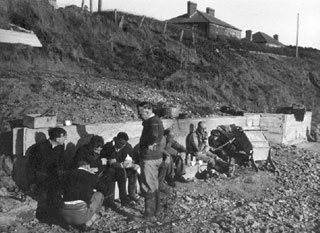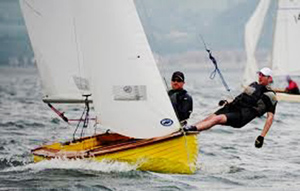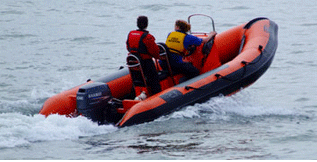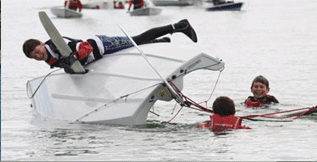|
Since
the turn of the century, sailors in the Sutton Creek
area had made various attempts to establish a club,
and around 1930 an liaison was formed with Howth Sailing
club, with meetings and social events taking place in
the Howth club premises, and actual dinghy sailing taking
place in Sutton Creek. As the yachtsmen in Howth and
Dun Laoghaire turned their attention more towards the
larger keelboats, local dinghy enthusiasts took the
opportunity to "go it alone". Early in May 1940, Sutton
Dinghy Club was launched, adding to the growing list
of East Coast sailing clubs.
 
For the first ten years of its existence, the members
used a small boathouse loaned by Desmond Keatinge, the
first Captain (the club could not afford a Commodore
at that time!). With Desmond at the helm, the committee
got down to the task of introducing a fleet of boats
to convince well wishers that the club was really alive,
and seven International 12 ft. Dinghies sailed their
first race under the new club burgee, which was (and
still is) blue with a white silhouette of the International
12 ft. dinghy. The "Twelves" no longer race here (but
one member has just brought one back this year!), and
the burgee is a reminder of those early days.
 
To raise funds for a clubhouse, they bought an I.D.R.A
14 ft. racing dinghy (one of the first ever built),
and raffled it, raising a total of £120. A permanent
site for the club was found, conveniently, not a hundred
yards from Desmond Keatinge's boathouse. Work commenced
building on the present site on November 16, 1948. Among
the members at the time, there were few who had trained
knowledge of what had to be done, but that was no deterrent
-it was a case of build or bust! It took three long,
cold winters to complete the work, with members (and
often wives, daughters, and sons roped in) dressed in
all manner of attire, digging, shovelling, hauling and
doing all that had to be done.

The official opening of the new clubhouse took place
on June 1st, 1951, by Douglas Heard, the then President
of the Irish Dinghy Racing Association (later the Irish
Yachting Association, now the Irish Sailing Association).
The boat park (or "Hardspace") could originally only
accommodate six dinghies, but was increased to between
thirty and forty over the following years. In 1967 the
hardspace was increased to its present size, and the
clubhouse was extended in 1980 to provide the function
room and better changing facilities, which were further
developed again during 1986, to improve the quality
of life ashore! The boats on the hard are also changing:
the International "Twelves" were soon joined by the
I.D.R.A. Fourteens, then Hornets, Enterprises, Fireballs,
Mirrors, G.P. Fourteens, Optimists, Lasers, among others,
became part of the ever evolving scene at Sutton Dinghy
Club.

The membership also evolved- Sutton sailors were family
men and women, and their children inevitably took to
the waters. Over the years, Junior sailing and Junior
training became more and more an important aspect of
the Club activities. At the same time, sailors everywhere
sought to improve the enjoyment of their sport by providing
a safer environment, particularly for novices: rescue
boats and equipment were bought and put into service
in every Club. The Sutton Dinghy Club fleet now consists
of three boats: a 16-foot Workboat and two Sea Rider
14-foot semi-rigid inflatable rescue launches.

1995
saw the beginning of a radical new direction for the
Club, a new joint venture which re-launched Sutton Dinghy
Club as a centre for dinghy sailing on the north side
of Dublin Bay. At the 1993 Annual General Meeting, concern
was expressed that Club activity would die out in the
foreseeable future - for various reasons, but mainly
due to the fact that the steady intake of children to
the Junior Training had all but dried up in the Sutton
area (indeed the following year saw the Club's nearest
neighbour, Kilbarrack Sailing Club, wind up its operations).
The annual Adult Sailing Course in Sutton had proved
that there are people out there who would like to learn
dinghy sailing - but with the reduced Club resources,
using members and their boats, this could only be run
for one week every year, and there was no adequate "follow-up"
to enable trainees to continue sailing without buying
their own boat.

One of the Sutton Dinghy Club members who spoke on the
subject at length at that AGM was Hugh Gill, who has
been representing the Club at the top national and international
level of the GP 14 fleet. At that time, Hugh was involved
with the Irish National Sailing School, who operated
out of Dun Laoghaire. He discussed the situation both
with his I.N.S.S. colleagues and with the Club Commodore,
Charles Sargent, and his Committee. These discussions
eventually resulted in an agreement to extend the I.N.S.S.
activities to the north side of the Bay, basing a fleet
of dinghies and a rescue boat in Sutton Dinghy Club.
These boats were used to provide sailing courses, both
for the general public, and for Club members. This arrangement,
which was designed to be of benefit to both the Club
and the Irish National Sailing School, achieved the
following:
· broadened the appeal of sailing to the wider public.
· developed Sutton Dinghy Club as a base for sailing
tuition.
·
encouraged full take up of sailing courses on offer.
· promoted Club membership among course graduates.
·
increased Club sailing by providing a fleet of dinghies
for charter.
The
agreement provided an on-going series of Adult Sailing
Courses, and Junior introductory courses, throughout
the sailing season, which attracted many graduates to
take up Club membership. In addition, the full I.S.A.
Junior Training programme was provided for Sutton Dinghy
Club junior members, using the Club rescue boats in
addition to the I.N.S.S. boat. This initial venture
with the I.N.S.S. was so successful that the Club decided
to continue the concept, but under the full control
of its membership, and in conjunction with a FAS-sponsored
Community Employment Project.
As
the Club activities expanded, and membership numbers
expanded beyond the existing capacity for boat parking,
discussion among members centred around the need for
a long-term plan for the club in order to ensure its
survival and viability beyond the millennium. The latest
development provides an additional 750 sq. metres of
parking for boats and cars, to cater for the existing
membership numbers.
The level and extent of Club activity increased with
the housing developments locally, and the Club facilities
were developed over the years to meet the changing aspects
of dinghy sailing in Sutton:
1960's: Increased membership, increasing number of
boats involved
Action:
Leased area extended (50-60 boats)
1970's:
Greater concentration on social aspect of membership
Action:
Clubhouse improved to provide social room & showers
1980's: Club involved in hosting National & Regional
championships
Action:
Extension to changing rooms & viewing balcony
1990's:
Malicious attacks on Clubhouse, Rescue Boats and members'
boats
Action:
Erected security fence and steel container for rescue
boats
2000's:
Insufficient parking space for members' boats
Action:
Extended existing "hard" to provide additional boat
& car parking
Some things don't change: every year, in conjunction
with the Royal Cork Yacht Club, there are inter-club
team races for both junior and senior sailors on a "home
and away" basis. For each winning team, there is a most
unique prize - they get to keep custody for twelve months
of the "Book", which is a written account, added to
year by year, of each race and the teams involved. This
sixty-year-old saga (apart from a few gaps here and
there when weather or illness intervened) of friendly
rivalry between these two Clubs includes many sailors
who went on to become internationally-renowned names
in the sailing world - read this Book to understand
where Harold Cudmore learned his tactical skills - by
bitter experience when racing against the Sutton sailors!
The
story of Sutton Dinghy Club and its members does not
stop here, rather it is .... to be continued!
|




